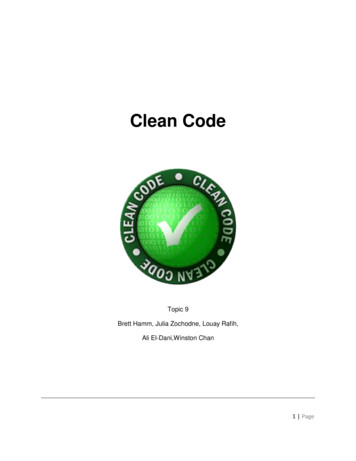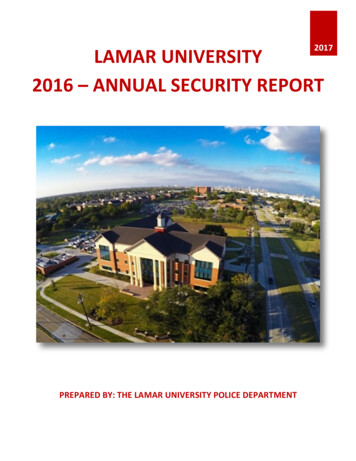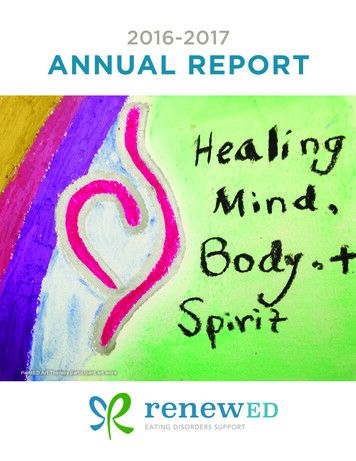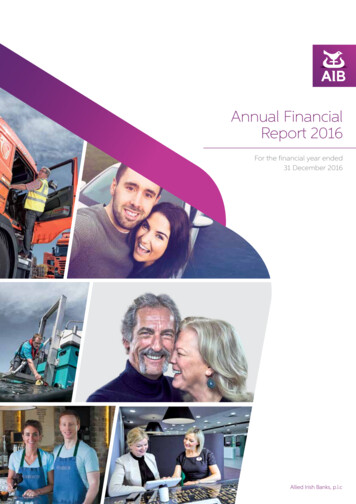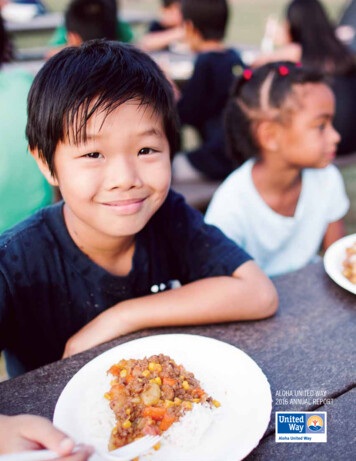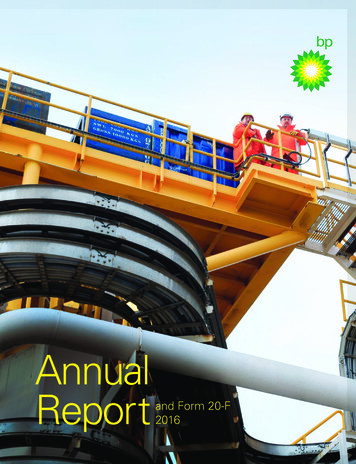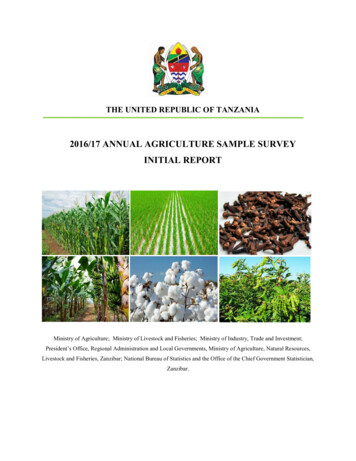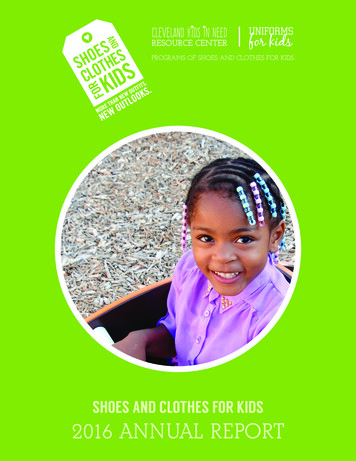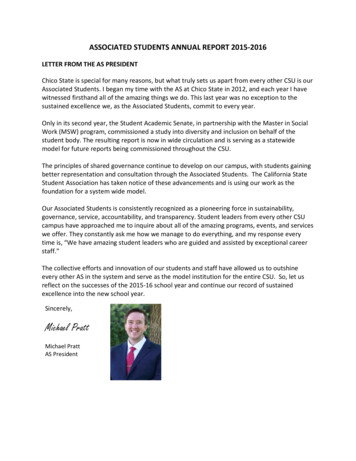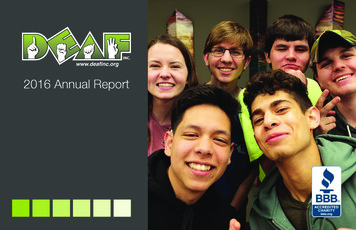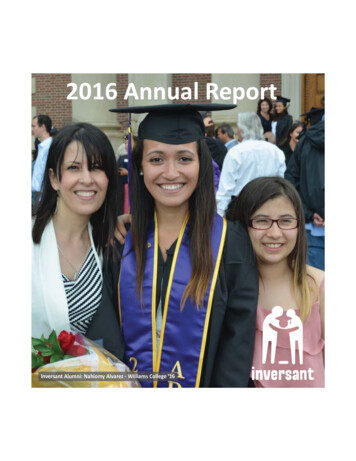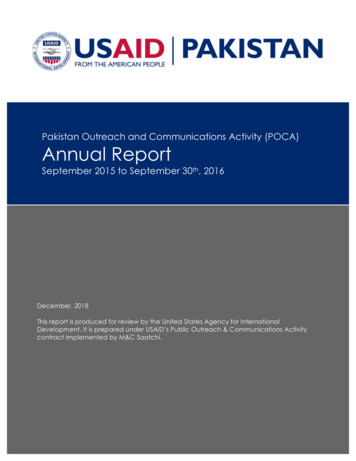
Transcription
Pakistan Outreach and Communications Activity (POCA)Annual ReportSeptember 2015 to September 30th, 2016December, 2018This report is produced for review by the United States Agency for InternationalDevelopment. It is prepared under USAID’s Public Outreach & Communications Activitycontract implemented by M&C Saatchi.
Program Name:Pakistan Outreach & Communications Activity (POCA)Activity Start Date AndEnd Date:September 2015 to December 2018Name of PrimeImplementing Partner:M&C Saatchi World ServicesContract/AgreementNumber:AID – 391 – C – 15 – 00014Geographic CoveragePakistanReporting Period:September 2015 to September 30th, 2016.Document:Submission Date:Contract Number:Submitted by:POCA Annual Report- Year 1December 13, 2018AID – 391 – C –15-00014 0001M&C SAATCHI WORLD SERVICES11th Floor Ufone Tower Blue Area, IslamabadTel: 051 2310571
CONTENTSAcronymsExecutive SummarySECTION 1Formative ResearchSECTION 2POCA Strategic ApproachSECTION 3Media CampaignsSupport to DOC OfficeCommunication Working GroupPR ActivitiesSocial Media Engagement
ACRONYMSCOPChief of PartyCORContracts Officer RepresentativesDCoPDeputy Chief of PartyDODevelopment ObjectiveFATAFederally Administered Tribal AreasFFPOffice of Food for PeaceG2GGovernment to GovernmentGBVGender-based ViolenceGDPGross Domestic ProductGOPGovernment of PakistanGoPbGovernment of PunjabHECHigher Education CommissionIMFInternational Monetary FundIRIntermediate Results KP Khyber PakhtunkhwaLCDLocal Capacity DevelopmentM&EMonitoring and EvaluationMDGMillennium Development GoalMOMission OrderMSFMission Strategic FrameworkSMEMicro, Small & Medium EnterpriseNGONon-Governmental OrganizationsOFDAOffice of Foreign Disaster AssistancePMUPerformance Management UnitPPRPerformance Plan and ReportUSGUnited States GovernmentXCOCrosscutting ObjectiveMCSWSM&C Saatchi World Services
Executive SummaryPakistan Outreach and Communication Activity (POCA) is implementing a 3 Yearmedia and communications campaign to increase Pakistani public awareness ofthe United States Government’s (the USG) development initiatives undertaken bythe U.S. Agency for International Development’s (USAID) Mission to the IslamicRepublic of Pakistan. In doing so, it ultimately seeks to build public support forachieving the objectives of U.S. foreign assistance programming in Pakistan. ThePOCA project is being implemented by M&C Saatchi World Services. The projectinitiated in 2015 with the above-mentioned objective.There was a shift in objectives- from lowering intense negativity to increasing publicperception and knowledge.The Baseline objectives:1. Raise awareness of US civilian assistance projects2. Lower intense un-favorability of US3. Reduce intense and total rejection of US assistance(Source: IPSOS 2015 Endline Survey)POCA is a unique project as it continues previous efforts to change perceptions andattitudes of Pakistanis about USAID and USG from negative to positive by raisingawareness about USAID/Pakistan’s development projects.There were mainly 2 areas in focus in Year One. Firstly, designing Research andsecondly, development of a New Strategy that would provide basis to formulate arobust communication strategy, which will subsequently lead to designing effectivecampaigns to achieve the contract objectives. Following the new strategy, MCSWteam developed its first media campaign, which successfully ran during Year One.To this end, a Formative Research Round One was commissioned in the initial year. Itwas imperative to build on the previous research to update attitudinal mapping. Theresearch was focused to ascertain Understanding Pakistanis- their priorities,challenges, comprehending Pakistanis perceptions about USAID and USG- theirrelationship followed by learning about the barriers and solutions for increasingabout USAID in Pakistan- helping in creating a positive perception change in favor ofUSAID/USG.The Formative Research Round One led MCSW team to develop strategic directionthat culminated in deriving and launching of a tag line ‘Aao Kur Dikhain’- ‘TogetherWe Can’- encompassing a partnership approach.The POCA Tag-Line was also formally launched through the first mainstream mediacampaign of Heritage.
SECTION 1PROJECT OVERVIEWPakistan Outreach and Communication Activity (POCA) is implementing a mediaand communications campaign to increase Pakistani public awareness of theUnited States Government’s (the USG) development initiatives undertaken by theU.S. Agency for International Development’s (USAID) Mission to the Islamic Republicof Pakistan. In doing so, it ultimately seeks to build public support for achieving theobjectives of U.S. foreign assistance programming in Pakistan.This activity continues previous efforts of the mission to move Pakistanis along thescale from only raising awareness about USAID/Pakistan’s development projects to(1) increasing support for USAID programmatic objectives to help ensure thesustainability of these initiatives; and (2) emphasizing the importance of thepartnership between the United States and Pakistan and how this partnership bringsabout tangible improvements for the Pakistani people.The POCA contract was signed between USAID and M&C SAATCHI WORLD SERVICESon September 08, 2015, and the completion date of the contract is September 7,2018. This 3-year project is being implemented by M&C Saatchi World Services. Thetwo main components of this project are:1) Comprehensive Nationwide Media Campaign2) Communication and Outreach SupportIn total there are six development objectives for this project, which are:1. To sustain and increase the awareness of USAID/Pakistan activities andprojects implemented in Pakistan, including the significant results achieved,by communicating the benefits of USAID’s work in Pakistan to Pakistanis at the“people level.”2. To increase the public perception of the USG and its developmentinterventions as implemented by USAID/Pakistan. This will include raising thePakistani level of confidence in the goals and implementation of USAIDprojects and activities.3. To Increase Pakistanis’ knowledge and understanding that USAID/Pakistan is aUSG entity.4. To provide support to the Development Outreach and Communication(“DOC”) Office of USAID/Pakistan. This will include the development andimplementation of outreach events and the utilization of social media as aplatform for communication, engagement, and exposure for USAID’s work inPakistan.5. s implementing partners.guidance/supportto
6. Working closely with USAID/Pakistan, the Offer or will demonstrate and applya deep knowledge of all aspects of Pakistani society to gain visibility for U.S.development assistance programs.SECTION 2Formative ResearchA Formative Citizen’s consultation and research was executed to understand andanalyze sentiment towards USG among the Pakistani public, awareness of the workundertaken by USAID, barriers to acceptance and ways to drive re-appraisal. Thisincludes a full analysis of media consumption habits and other cultural referencepoints.Consultation comprised of 32 focus groups covering all key regions anddemographics, with an even gender and urban/ rural split.The emphasis of the POCA contract objectives was clearly towards increasing publicperception and knowledge, as opposed to lowering intense negativityIn order to gain knowledge and insight into the strategic communication task, theMCSWS team conduced Formative Consultation Groups, with the fieldworkconducted in 2015. These qualitative groups were conducted in a mannerrepresentative of the population of Pakistan. The Formative Consultation Groups hadthree main objectives:a. To understand the Pakistani public’s perception of the USb. To gauge the relationship and linkage between USD and UGSc. To identify the barriers and solutions to inform a strategy towards a majorperception changeThe national program comprised of 32 Focus Group Discussions (FGD’s) of 120minute duration with recruitment carefully weighted to provide a representativenational cross section. This included: 12 male groups and 12 female, 12 urban and 20rural, an even split between under 25’s and over, plus an even balance betweenthose whose perceptions of USG tended to be more positive, and those whose’tended to the negative as shown in Figure 1 below.
One of the key strategic outputs derived from the Formative Citizen ConsultationGroups were definitions of the target audience. The audiences were selected basedon attitudes towards US, age, and Socio Economic Groups. The key audiencesselected for the POCA Strategic Communications can be summarized in Figure 2below:Main target group 1 Young, Low Educated, Semi Skilled. Correspond to SEC D, 15-29 year olds. Their Influencers: TV Anchors, Military Leadership, Politicians, Elders in KP (for KP youth) All Barriers applyMain target group 2Province wise population split will apply, as perdemographics of Pakistan Young, College Educated, Semi Skilled. Correspond to SEC C, 15-29 year olds. Their Influencers: TV Anchors, Military Leadership, Politicians, Elders in KP (for KP youth). All Barriers applyRegional emphasis group 1 Lower educated males and females in Sindh, SEC D, 15-29 year olds. Barrier Emphasis: Lack of awareness.Regional emphasis group 2 Middle educated males and females in Balochistan. Correspond to SEC C, 15-29 year olds. Barrier Emphasis: Lack of awareness.We need to ensure these groups don’t get left outRegional emphasis group 3 Females in Balochistan. Correspond to SEC C, 15-29 year olds. Barrier Emphasis: Cultural disconnect.Another key strategic output was the consolidated analysis of barriers towardspositive perception change towards USAID / USG, and solutions to those barriers. Thisanalysis has been instrumental in helping the M&C Saatchi World Services teamformulate a sophisticated step by step strategy to achieve the POCA contractobjectives as illustrated in Figure 3 below:AUDIENCE BARRIERS (FROM)People don’t fully trust theintentions of USAID / USGPeople feel there is a lack ofTransparency & perceivedCorruption linked to USAID’sactivitiesLack of awareness andunderstanding of USAIDactivitiesBelief that USA drives an AntiIslamic agendaCultural disconnect betweenUSAID and the people ofPakistanImplicitly demonstratelocal knowledge andrespect for Islam in PakistanImplicitly demonstrateknowledge, appreciationand respect for Pakistanicultural normsROLES OF COMMUNICATION (TO)Clearly explain WHY USAID isoperating in Pakistan in agenuine and believablemannerEducate people aboutwhere the money is spent,and our work with trustedlocal partnersIncrease awareness ofUSAID’s activities, and howthey impact the deservingpeople of Pakistan
Using the responses from our two rounds of national formative research, weidentified a clear spectrum of negative to positive opinion towards USG, which wecategorized in six segments, based on attitude, education and age. From this wewere able to identify the two most promising targets to drive perception changetowards USAID at the volume required.Segmentation based on attitudes towards USAMain TargetGroup 1Main targetGroup 2- VE VEYoung, LowEducated, SemiSkilledYoung, College Educated,SkilledPerceptionstowards USAThink of USA as NotFriendly, Anti-Muslim,Causes terrorismEnemyPerceptionstowards USAUnsureCombats terrorismEnemy, Hidden agendaCorresponds toSEC CCorresponds toSEC D/EThis forms a congruent group whowe can treat as our main targetaudience. The profiles correspondto Middle Class, SEC C & D, males &females, aged 15-29.Source: M&C Saatchi World Services Citizen ConsultationWho?What?How?When?M&C Saatchi World Services9Output: Vq9SdeJsyn-1YRk/view?usp sharingThe STRATEGIC APPROACHBuilding and Testing a Communications StrategyOverall, the research pointed to a strategic approach which built awareness ofUSAID and its work in Pakistan, specifically re-framing it in three important ways:1. Demonstrate the impact that USAID was having across Pakistan on the lives ofmillions of ordinary people (real people and true stories, visible evidence, notfacts and figures)2. Establish that USAID was not an “external” aid giver, but a long-term partnerof Pakistan, working together to achieve results3. Address USAID’s motivation – a strong and prosperous Pakistan is in bothcountry’s national interest. Unlike countries such as China and Saudi Arabia,who’s assistance is not questioned, because they are seen to be “friends”, themutual self-interest behind USG interventions must be substantiated.This new approach was broken and would be used to address the specific barriers to
Overlaying all these tasks was the central unifying theme of our strategy –demonstrate that USAID was working TOGETHER with the people of Pakistan toimprove the lives of millions.The emphasis on working together was critical for 3 key reasons:1. It positioned USAID as a partner with Pakistan, not as an outsider or selfinterested operator2. Established a collaborative tone of voice in all communications, mitigatingthe risk of these being dismissed a “patronising” or “propaganda”3. Showed respect to Pakistanis, mitigating suspicions about USG’s negativeattitudes towards them.Launching the new strategic platformThe POCA team built a sequential campaign phasing, designed to address the keybarriers to improved perception of USAID/ USG in three logical phases:1. Establish credibility by demonstrating the depth of the partnership betweenUSAID and Pakistan, stretching back 70 years2. Demonstrate the current impact of the partnership on the lives of ordinaryPakistanis, and tackle skepticism3. Show the benefits of the partnership to Pakistan’s young people specifically,and initiate a discussion about the future benefits of an enduring partnershipto their lives and to their country’s future success.Creating a unifying campaign platform:Once the key strategic theme of partnership was established, our task was to find
11th Floor Ufone Tower Blue Area, Islamabad Tel: 051 2310571 . CONTENTS Acronyms Executive Summary SECTION 1 Formative Research SECTION 2 POCA Strategic Approach SECTION 3 Media Campaigns Support to DOC Office Communication Working Group PR Activities Social Media Engagement . ACRONYMS COP Chief of Party COR Contracts Officer Representatives DCoP Deputy
